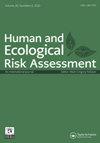Ecological and human health risk assessment of agricultural soils based on heavy metals in mining areas of Singhbhum copper belt, India
IF 2.7
3区 环境科学与生态学
Q2 ENVIRONMENTAL SCIENCES
引用次数: 29
Abstract
ABSTRACT Risk characterization of agricultural soils in the mining areas of Singhbhum copper belt was done by determining the total concentrations of metals using inductively coupled plasma-mass spectrometry and assessing the potential ecological and human health risks. The concentrations were above the average shale values for most of the metals. Principal component analysis showed anthropogenic contributions of Cu, Ni, Co, Mn, Pb, and Cr in the soils. Ecological risk assessment revealed that 50% of the soil samples were at moderate to very high ecological risk. Health risks for adults and children were calculated using hazard quotients (HQs), hazard index (HI), and Cancer risks for the oral, dermal, and inhalation pathways. The HQs for all the metals except As and Co were below 1, which suggested that non-carcinogenic risks due to metal exposure through soils were within the safe limit. However, considering all the metals and pathways, the HI for adults and children was 0.71 and 5.61, respectively, suggesting appreciable risk to local residents. The carcinogenic risks due to As and Cr in the soils were within the acceptable value of 1E–04. For both carcinogenic and non-carcinogenic risks, oral ingestion appeared to be the primary pathway followed by dermal and inhalation pathways.基于印度Singhbhum铜带矿区重金属的农业土壤生态和人类健康风险评估
摘要采用电感耦合等离子体质谱法测定铜带矿区农业土壤中金属的总浓度,并评估潜在的生态和人类健康风险,对铜带矿区农业土壤进行风险表征。大多数金属的浓度都高于页岩的平均值。主成分分析表明,土壤中Cu、Ni、Co、Mn、Pb和Cr的人为贡献。生态风险评价结果显示,50%的土壤样品处于中等至极高的生态风险。使用危害商数(HQs)、危害指数(HI)和口腔、皮肤和吸入途径的癌症风险来计算成人和儿童的健康风险。除As和Co外,其他金属的HQs均低于1,表明金属通过土壤接触的非致癌风险在安全范围内。然而,考虑到所有的金属和途径,成人和儿童的HI分别为0.71和5.61,表明当地居民有明显的风险。土壤中砷、铬的致癌风险均在可接受值1E-04以内。对于致癌性和非致癌性风险,口服摄入似乎是主要途径,其次是皮肤和吸入途径。
本文章由计算机程序翻译,如有差异,请以英文原文为准。
求助全文
约1分钟内获得全文
求助全文
来源期刊

Human and Ecological Risk Assessment
环境科学-环境科学
CiteScore
9.60
自引率
2.30%
发文量
68
审稿时长
2 months
期刊介绍:
Human and Ecological Risk Assessment provides a resource for professionals researching and assessing environmental hazards to both humans and ecological systems. The editors expect papers published to be original, of sound science, purposeful for risk analysis (assessment, communication, management) and related areas, well written (in English), and a contribution to the scientific literature.
The journal''s emphasis is on publication of papers that contribute to improvements in human and ecological health. The journal is an international, fully peer-reviewed publication that publishes eight issues annually. The journal''s scope includes scientific and technical information and critical analysis in the following areas:
-Quantitative Risk Assessment-
Comparative Risk Assessment-
Integrated Human & Ecological Risk Assessment-
Risk Assessment Applications to Human & Ecosystems Health-
Exposure Assessment-
Environmental Fate Assessment-
Multi-Media Assessment-
Hazard Assessment-
Environmental Epidemiology-
Statistical Models and Methods-
Methods Development/Improvement-
Toxicokinetics Modeling-
Animal to Human Extrapolation-
Risk Perception/Communication-
Risk Management-
Regulatory Issues
 求助内容:
求助内容: 应助结果提醒方式:
应助结果提醒方式:


